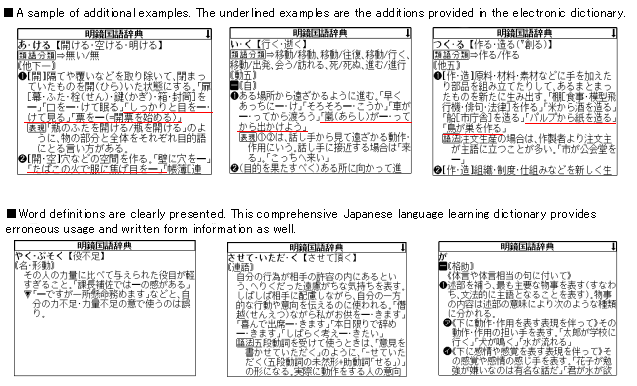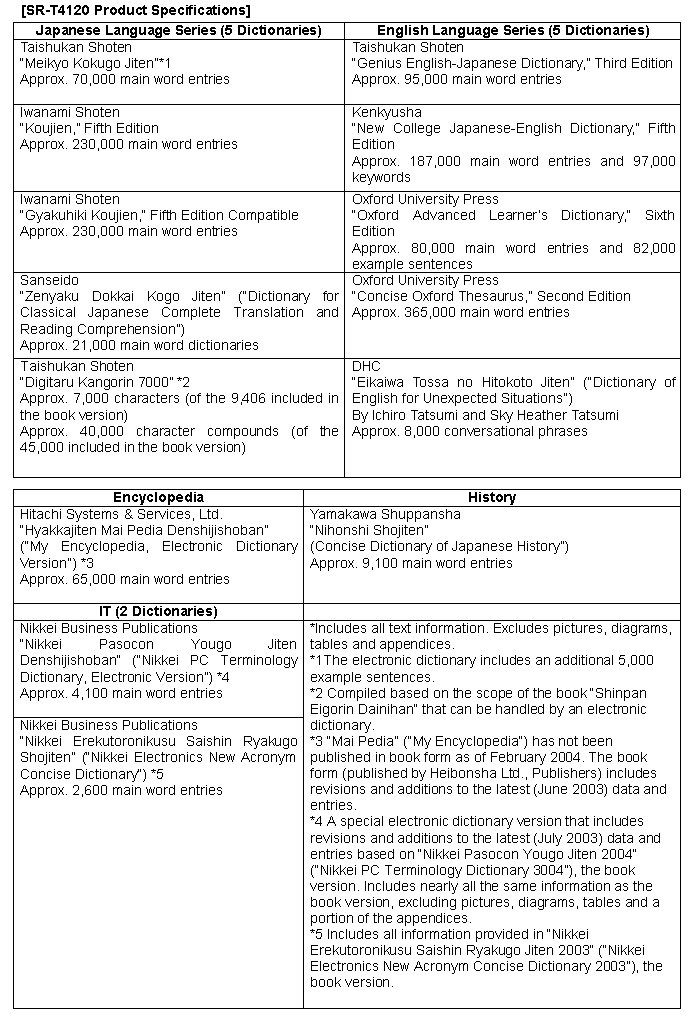
Seiko Instruments Inc. (Abbreviation: SII; President, COO & CFO: Yukihiko Chayama; Head Office: 1-8 Nakase, Mihama-ku, Chiba City, Chiba Prefecture; Tel: 043-211-1111) will release the electronic dictionary “IC DICTIONARY SR-T4120,” which includes dictionaries ideal for high school students studying the Japanese language, such as Taishukan Shoten’s Japanese language dictionary “Meikyo Kokugo Jiten,” which makes its first electronic dictionary debut with SR-T4120 (*1), and Yamakawa Shuppansha’s highly acclaimed history book “Nihonshi Shojiten” (“Concise Dictionary of Japanese History”), and is equipped with an orthodox keyboard enabling input with a PC-like feel.
The new product “SR-T4120” is an electronic dictionary with an enhancement of Japanese language, which includes two Japanese language dictionaries and an encyclopedia. In recent years, corruptions in language have been reviewed with respect to proper Japanese language usage, drawing much attention to Japanese language dictionaries that not only permit meaning lookup but also allow the user to attain detailed knowledge and an understanding regarding factors such as target word usage and its written form.
Taishukan Shoten’s “Meikyo Kokugo Jiten,” which is included in “SR-T4120,” is reputed as a Japanese language dictionary that does just that. By combining Taishukan Shoten’s “Meikyo Kokugo Jiten” with Iwanuma Shoten’s “Koujien” and “Hyakkajiten Mai Pedia Denshijishoban” (“My Encyclopedia, Electronic Dictionary Version”) and by further including the “Zenyaku Dokkai Kogo Jiten” (“Dictionary for Classical Japanese Complete Translation and Reading Comprehension”), a must-have for the high school student studying classical Japanese, and “Digitaru Kangorin 7000,” the digital version of the dictionary considered the old standby amongst recommended high school level Chinese-Japanese character dictionaries, “SR-T4120” is an electronic dictionary for high school students of a generation to be trained in proper, elegant Japanese. Function-wise, the “Meikyo Kokugo Jiten” is newly equipped with a two-way search function (synonym display and synonym search), allowing use as a thesaurus as well, thereby enabling the language student to increase his or her knowledge of words with similar meanings.
The new dictionary also includes new genre dictionaries, such as Yamakawa Shuppansha’s “Nihonshi Shojiten” (“Concise Dictionary of Japanese History”), an aid even in “Social Studies” and “IT (Computer)” coursework, Nikkei Business Publications’ “Nikkei Pasocon Yougo Jiten Denshijishoban” (“Nikkei PC Terminology Dictionary, Electronic Version”), Nikkei Business Publications’ “Nikkei Erekutoronikusu Saishin Ryakugo Shojiten” (“Nikkei Electronics New Acronym Concise Dictionary”) and five types of English dictionaries, including English-Japanese, Japanese-English and English-English dictionaries.
The new product “SR-T4120” is a must-have electronic dictionary which combined all suitable dictionaries such as Japanese language, an encyclopedia, classical Japanese, Chinese characters, English language, history and IT, supporting learning of high school students from all different angles.
*1: As of February 2004
[Main Features of Included Dictionaries]
1.Simultaneous inclusion of the two Japanese language dictionaries “Meikyo Kokugo Jiten” and “Koujien” and “Hyakkajiten Mai Pedia” (“My Encyclopedia”)
The new dictionary is the first electronic dictionary to include Taishukan Shoten’s “Meikyo Kokugo Jiten.” The dictionary also includes “Koujien,” a well-reputed Japanese language reference with encyclopedia-type entries, and “Hyakkajiten Mai Pedia Denshijishoban” (“My Encyclopedia, Electronic Dictionary Version”), which provides knowledge across a variety of fields, including biographies, academia, social studies and the household. The “Meikyo Kokugo Jiten” identifies meaning and offers detailed explanations based on sentence pattern. In addition, the Japanese language dictionary is compiled based on a variety of innovations that reflect a new departure from conventional Japanese language dictionaries, such as the presentation of explanations of appropriate Japanese character usage based on nuance, thereby aiding the user in Japanese language learning. The dictionary lets the language learner look up a single word using multiple dictionaries of the same genre and compare entries, making the task not just one of word lookup but a fun process of entry comparison while broadening the learner’s use and knowledge of words. Because the electronic dictionary is free of space restrictions, the “Meikyo Kokugo Jiten” includes an additional 5,000 examples that are not included in the book version, focusing primarily on verb entries. By providing the additional examples, the dictionary offers a greater abundance of information for understanding appropria

2.Yamakawa Shuppansha’s “Nihonshi Shojiten” (“A Concise Dictionary of Japanese History”), a highly acclaimed history book
The “Nihonshi Shojiten” (“A Concise Dictionary of Japanese History”) makes history learning fun. The dictionary helps the user not only with Japanese history learning and research, but also with comprehension of the historical context of events, people, systems, customs and place names, for instance, when reading literary works or visiting a foreign land.
3.Nikkei Business Publications’ “Nikkei PC Yougo Jiten” (“Nikkei PC Terminology Dictionary”) and “Nikkei Erekutoronikusu Saishin Ryakugo Shojiten” (“Nikkei Electronics New Acronym Concise Dictionary”) for quick comprehension of PC terminology and acronyms
The new model also includes Nikkei Business Publications’ “Nikkei PC Yougo Jiten” (“Nikkei PC Terminology Dictionary”) and “Nikkei Erekutoronikusu Saishin Ryakugo Shojiten” (“Nikkei Electronics New Acronym Concise Dictionary”). Computer and electronics related terminology that frequently appears in the various media changes quickly and is difficult to grasp when heard just once. These reference books (dictionaries) help the user easily comprehend such difficult terminology.
[Main Search Features]
1.A new “Meikyo synonym search feature” that enables use of “Meikyo Kokugo Jiten” as a Japanese Thesaurus as well
The “Meikyo Kokugo Jiten” groups entries with similar meanings, enabling use as a thesaurus as well. The dictionary provides a two-way search feature, letting you perform a search using a word that appears in a definition or perform a search directly. Enabling use of the dictionary as a thesaurus in addition to definition, usage and written form lookup, this feature is extremely helpful.

2.A “multiple dictionary example search feature” which lets you search five dictionaries simultaneously for example sentences
Example sentences that appear in a dictionary are an extremely useful reference for understanding word (vocabulary) usage and nuance when writing a paper. This feature lets you search all available example sentences for a specified English word at the same time.
The dictionaries subject to example searches are: [1] “Genius English-Japanese Dictionary (Third Edition),” [2] “New College Japanese-English Dictionary (Fifth Edition),” [3] “Oxford Advanced Learner’s Dictionary,” [4] “Concise Oxford Thesaurus” and [5] “Eikawa Tossa no Hitokoto Jiten” (“Dictionary of English for Unexpected Situations”).
3.A “super jump feature” that enables easy lookup and entry comparison with multiple dictionaries
When an unfamiliar word appears in a dictionary, the super jump feature automatically identifies the jump category (Japanese jump or English jump) by the character type specified by the cursor, allowing the user to jump to the dictionary of choice. This feature lets the user perform operations without having to take note of whether the language is Japanese or English.
4.A “real-time search & preview feature” that decreases the number of operational steps
This feature simultaneously executes a real-time search while suggesting and narrowing down possible entries as the user enters each character, giving a preview in the lower half of the same screen to display the translation of the possible entry highlighted above. As a result, the information that naturally enters a person’s field of vision when searching for a word while scanning pages in a paper dictionary is achieved with an electronic dictionary as well.
5. A conjugation search engine “word inflector feature” that allows the user to search for a word without paying attention to the word form
The word inflector feature displays the root form of a conjugated word, thereby allowing the user to search for a word without paying attention to the word form, such as irregular form, plural form and past tense.
6. A “vocabulary notebook feature” capable of recording looked up words
The vocabulary notebook feature can record a maximum of 1,000 words for all dictionaries combined, without any restrictions regarding the number of recorded words per dictionary. This feature can also record items other than words, including examples found using the example sentence search feature, idiomatic expressions, Koujien idiomatic phrases and Kanjigen compound words. The recorded vocabulary can be deleted as desired and maintained in memory even during battery replacement.
7. A wild card search feature (supports both single and multiple characters)
Regardless of whether the target word is in English or Japanese, this feature allows the user to search for an unknown word by placing a question mark or asterisk in the unknown location within the word. The feature can be used in various ways, such as combining the question mark and asterisk with the character(s) to be searched, for example: “ma*a??”. There are no restrictions pertaining to the wildcard location: the question mark or asterisk can be placed at the start, in the middle, or at the end of a word. This feature can be used to solve crossword puzzles as well.
Other available features include an English conversation keyword search, concise dictionary search by Koujien field (independent from the phrase search); hyperlink; spell check; idiom (phrase) search; character reading, radical reading, radical stroke count, partial radical stroke count and total stroke count search; mode key ON; font size switching; history (100 items); environment settings; and calculator features.

Display configuration: 240~320 dot matrix FSTN black and white liquid crystal
Display characters: 13 characters x 8 lines for 24 point (double-byte), 20 characters x 13 lines for 16 point (double-byte), 26 characters x 17 lines for 12 point (double-byte)
Operating temperature range: 0-40C
Key arrangement: QWERTY, plastic keys
Size: 137 (Width) x 88 (Depth) x 15.6 (Thickness) mm (closed)
Battery: Type 4 AAA dry-cell battery x 2
Battery service life: Approx. 90 hours for an alkaline dry-cell battery (when continuously displayed)
Weight: Approx. 210g (with batteries)
[Price]
Recommended retail price: 38,850 yen (tax not included)
(Main unit price: 37,000 yen)
[Target sales amount]
10,000 units/month
[Sale start date]
End of February 2004
Contact Information
Press Contact
Seiko Instruments Inc.
Corporate Communications Dept.
Arai
Fax:+81-43-211-8011
Product Inquiry
Seiko Instruments Inc.
CP Service Center
Tel:+81-47-320-4696